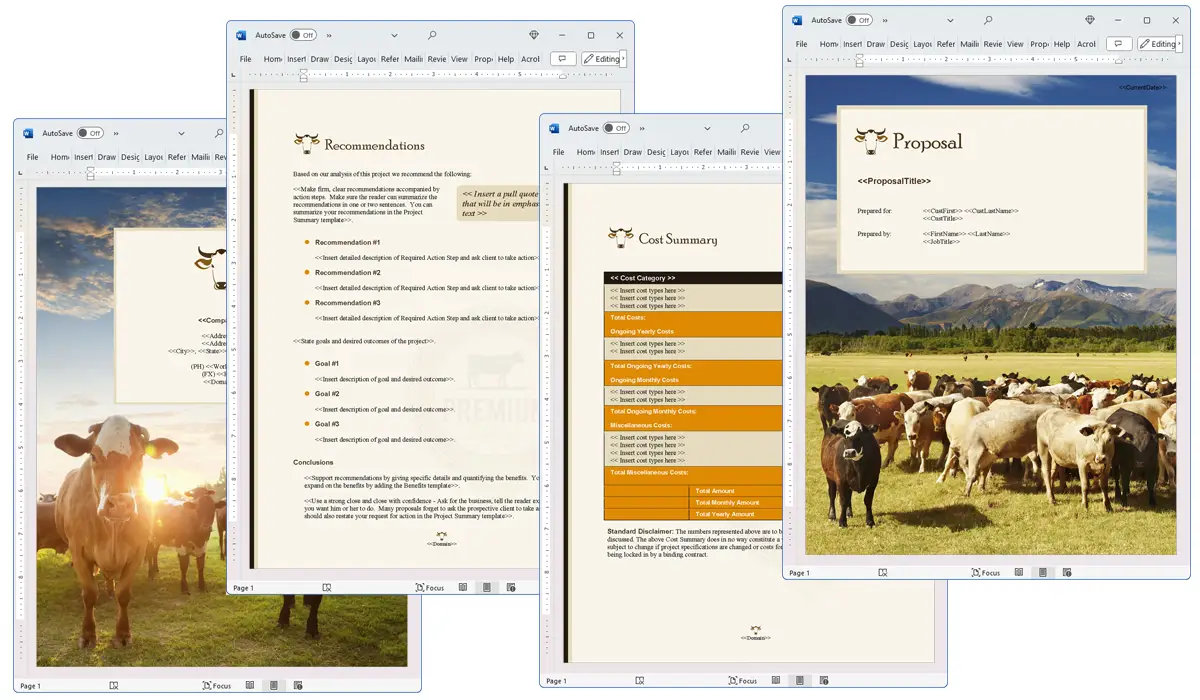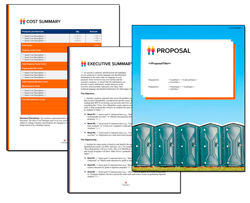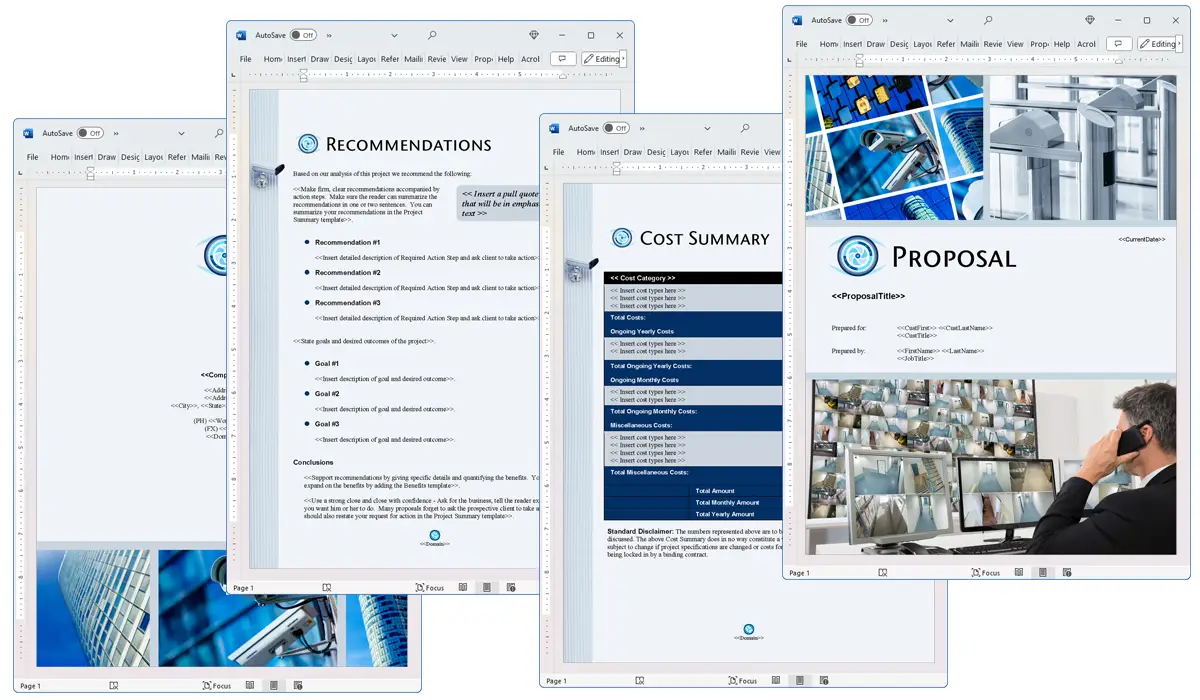What is the Second World chapter used for?
Proposal Kit Professional Bundle adds more design themes, all six Contract Packs,
a project management library, and Expert Edition software.

Illustration of Proposal Pack Ranching #1
We include this Second World chapter template in every Proposal Pack, along with thousands more. You assemble this chapter with others in various combinations to create custom-tailored business proposals, plans, reports, and other documents. Proposal Packs apply custom visual designs to the templates, giving the final documents a consistent professional finish.
 DOWNLOADABLE, ONE-TIME COST, NO SUBSCRIPTION FEES
DOWNLOADABLE, ONE-TIME COST, NO SUBSCRIPTION FEES
Overview of the Second World Chapter
The Second World chapter is a specialized template designed to help businesses communicate how developing countries, or "Second World" nations, interact with their organization. This chapter is crucial for organizations aiming to expand or operate in these markets, as it addresses unique challenges and opportunities. It helps in framing discussions around marketing strategies, potential responses to products or services, and the overall alignment of business objectives with the socio-economic dynamics of these countries.
How is the Second World Chapter Used?
When used in a business proposal, the Second World chapter is used to tailor the content to address the specific needs and circumstances of developing countries. It allows businesses to present their ideas, products, or services while considering the particular economic, cultural, and regulatory environments of these nations. This chapter helps in building a case for why these markets are significant and how the proposed offerings are suitable for them. It's instrumental in proposals aimed at investors or partners who are involved in international markets, providing them with targeted insights and strategies.
What is Included in the Second World Chapter?
This chapter typically includes several key elements:
- Market Analysis: An assessment of the current market conditions in the Second World countries relevant to the business's sector.
- Cultural Considerations: Insights into the cultural nuances that may affect the reception of a product or service.
- Economic Impact: Discussion on how the business's offerings might impact the local economy positively or negatively.
- Regulatory Environment: Information about any local laws that could influence business operations.
- Strategic Recommendations: Tailored strategies for entry or expansion into these markets, which could include partnerships, localization of services, or community engagement plans.
Use Case Examples for the Second World Chapter
- Supply Chain: Proposing a new distribution network that minimizes costs and enhances product availability in underdeveloped areas.
- Logistics: Developing tailored logistics solutions that address infrastructural challenges prevalent in Second World countries.
- Transportation: Introducing eco-friendly transportation solutions that are both affordable and suitable for less developed urban areas.
- International: Creating international expansion plans that emphasize cultural compatibility and economic viability.
- Government: Presenting to government bodies about public-private partnerships to improve local industries.
- Non-Profits: Outlining how a non-profit can work with local communities to boost economic development.
- Plans: Creating detailed business plans that focus on long-term sustainability in volatile markets.
- Reports: Compiling research reports that analyze the feasibility of entering specific Second World markets.
- Studies: Conducting studies to understand consumer behavior and preferences in developing countries.
- General Information: Providing general background information to stakeholders about the potential and challenges in these markets.
Key Takeaways
- The Second World chapter is important for businesses looking to operate or expand in developing countries.
- It includes tailored content that addresses cultural, economic, and regulatory aspects specific to these markets.
- This chapter is and can be used in a variety of industries including logistics, non-profits, and international business.
- The included recommendations help companies formulate actionable plans suitable for Second World countries.
- Understanding and using the Second World chapter can significantly enhance the relevance and effectiveness of a business proposal targeting developing nations.

Illustration of Proposal Pack Sanitation #2
 What Our Clients Say
What Our Clients SayThis program is very easy to use and is written layman’s terms. There are no difficult legal terms to figure out. I like this program and recommend it to anyone who wants to create a quick document for business purposes."
E. P. Willard Business Systems Inc.
 4.7 stars, based on 849 reviews
4.7 stars, based on 849 reviewsRelated Chapters

The Second World chapter and other chapters are integrated into a Word document as illustrated here in the Proposal Pack Security #8 design theme. There are hundreds of design themes available, and every design theme includes the Second World chapter template.
A proper business proposal will include multiple chapters. This chapter is just one of many you can build into your proposal. We include the complete fill-in-the-blank template in our Proposal Pack template collections. We also include a library of sample proposals illustrating how companies in different industries, both large and small, have written proposals using our Proposal Packs. This template will show you how to write the Second World.
We include a chapter library for you to build from based on your needs. All proposals are different and have different needs and goals. Pick the chapters from our collection and organize them as needed for your proposal.
Using the Proposal Pack template library, you can create any business proposal, report, study, plan, or document.
The Wizard software includes an AI Writer, which will write the content of this and any other chapter of your document. Use the AI Writer to do the heavy lifting, writing the first draft of your proposal or business document in minutes.
 Ian Lauder has been helping businesses write their proposals and contracts for two decades. Ian is the owner and founder of Proposal Kit, one of the original sources of business proposal and contract software products started in 1997.
Ian Lauder has been helping businesses write their proposals and contracts for two decades. Ian is the owner and founder of Proposal Kit, one of the original sources of business proposal and contract software products started in 1997.By Ian Lauder
 Published by Proposal Kit, Inc.
Published by Proposal Kit, Inc.


 Cart
Cart
 Facebook
Facebook YouTube
YouTube Bluesky
Bluesky Search Site
Search Site